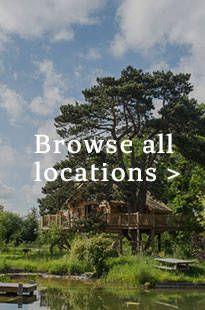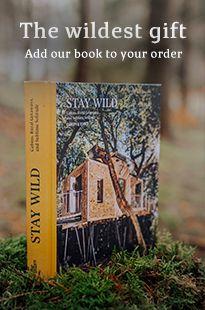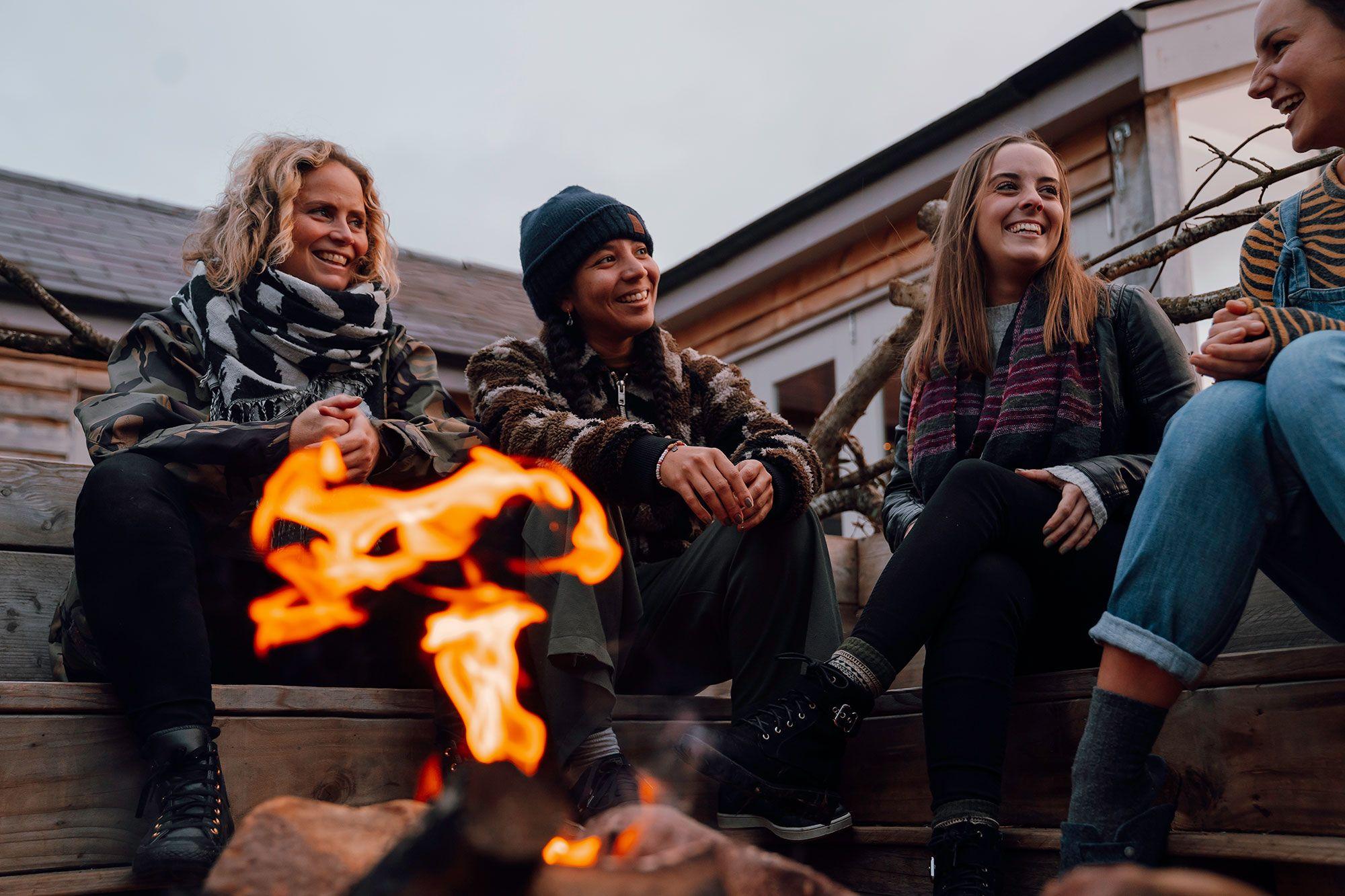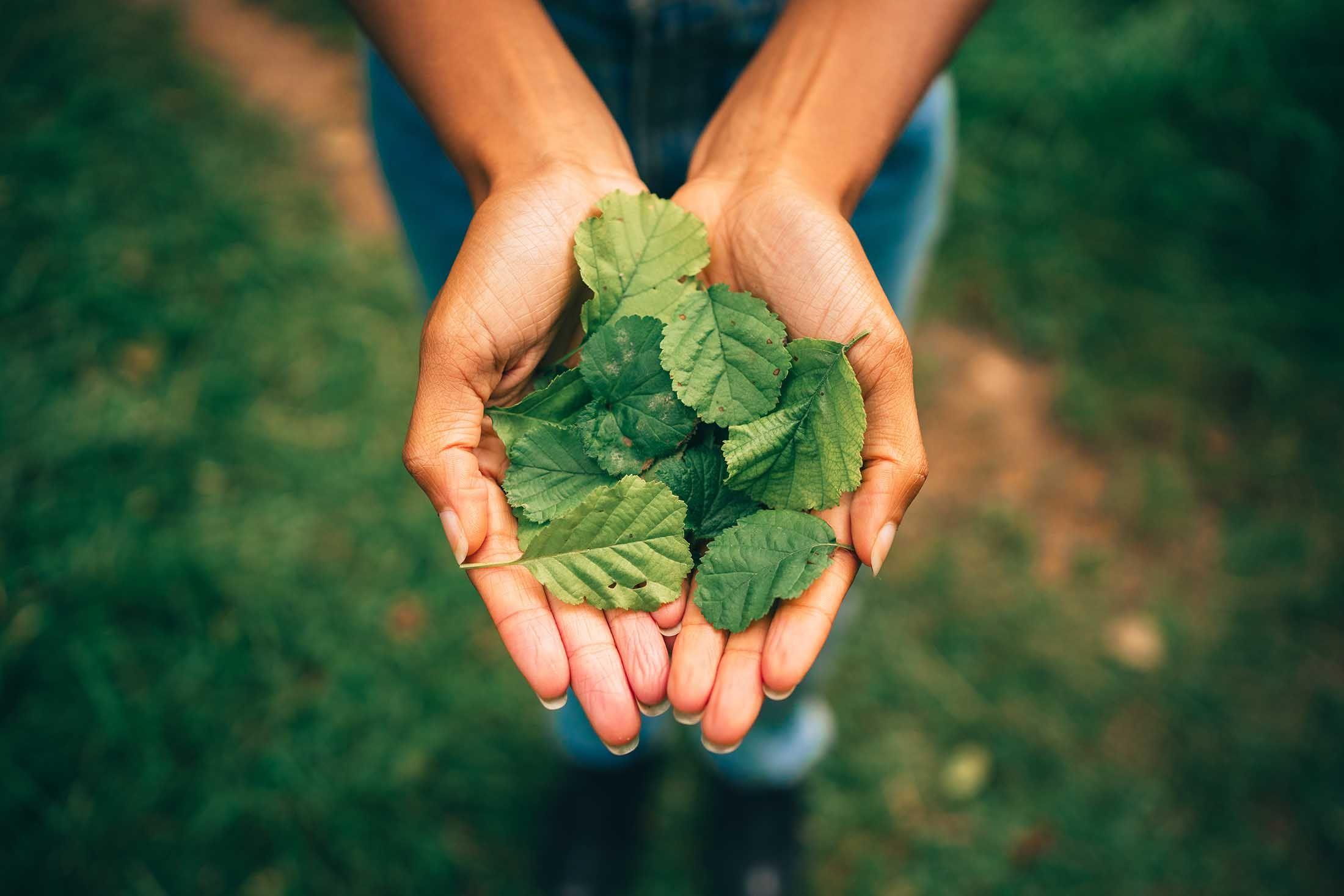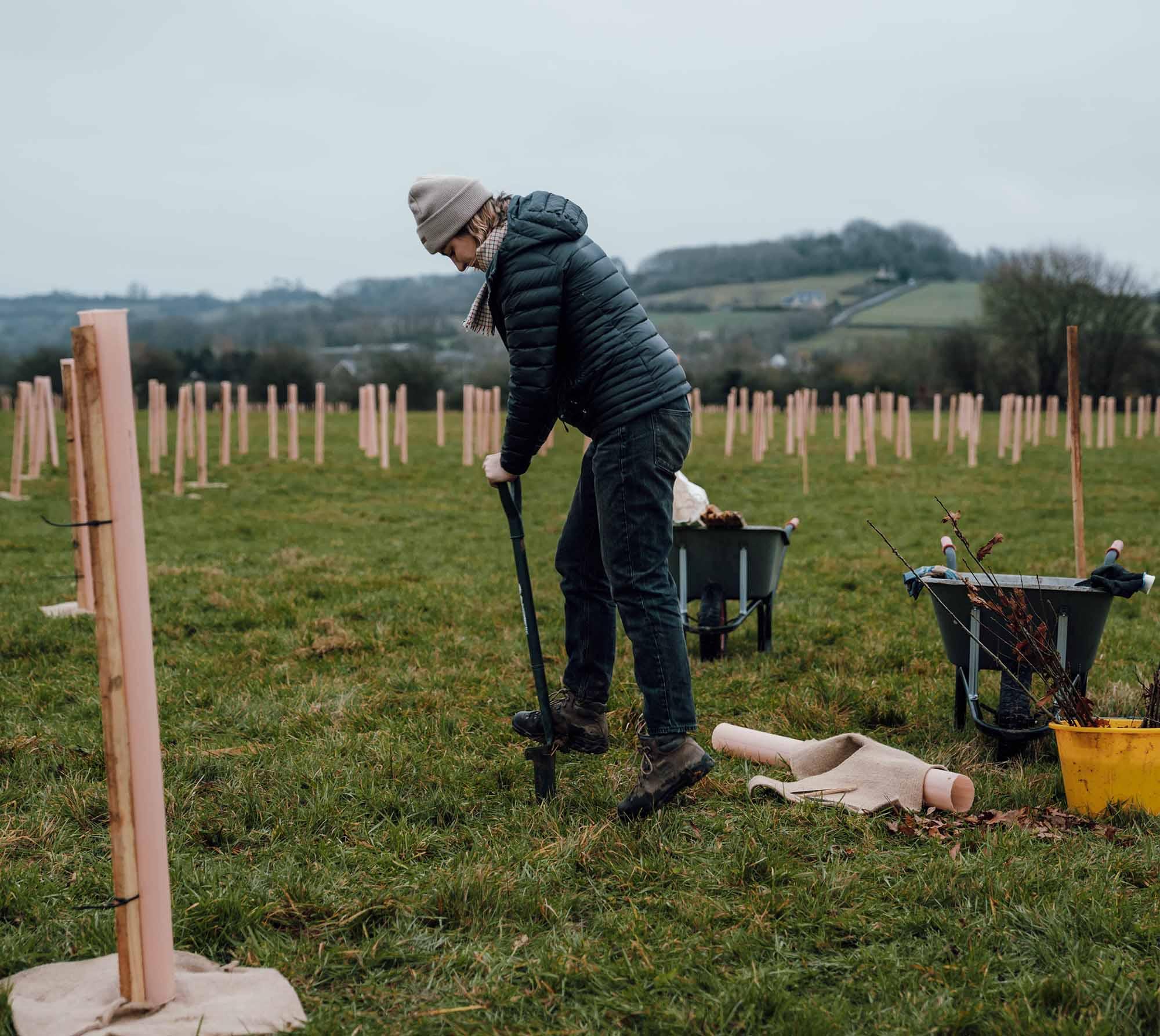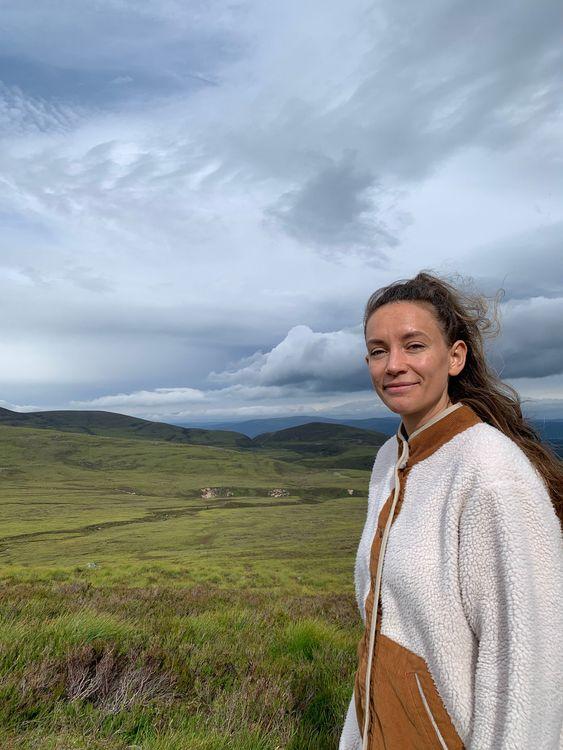
A life More Wild – Series 4, Episode 9
Lise Wortley
Join Lise Wortley in the Cairngorms, where she once spent a month following in the footsteps and wearing the heavy tweeds of writer and hiker Nan Shepherd
If you'd been out walking in the Cairngorms a few years ago, you might have seen a strange sight, a woman hiking in heavy tweed, hobnail boots, soaked to the bone. This was Lise Wortley, following in the footsteps of the writer Nan Shepherd on a month-long journey in the mountains, as part of a mission to bring female explorers and venturers, the prominence they deserve.
So, this one's interesting for me, because, well, I've fallen in love with Nan shepherd, and I'm not necessarily about just going to the top of things, because it's there, but for me, it's about understanding how she would have felt when she did it back then.
Lise is an ambassador for Passenger Clothing, a responsible outdoor clothing brand with a mission to inspire meaningful escapism. This summer, we've been working with them on a few different exciting projects, including a series of videos with some of this season's podcast guests. We've also teamed up to create a pop-up holiday bus in the Lake District, thanks to them for sponsoring this podcast episode.
Join Lise now as she revisits the Cairngorms, this time in modern clothing, to talk about yak wool coats, fluorescent moss, and the feeling of closeness to nature that comes from being permanently drenched.
Yeah, so I'm Lise, and I run a project called Women With Altitude. I started about seven years ago, and it's all about, I guess, highlighting all the women, adventurous women, that have been missed from history, that never got the same sort of coverage or respect that the men did at the time. And over my years of research, I found that there's so many amazing women with incredible stories, they’re really inspiring stories, that did such cool stuff, and they're just not in the history books. No one's ever heard of them. And yeah, so I kind of started that, and we're here in the Cairngorm's, because I came here to follow in the footsteps of one of them. So that's what I do. I follow in the footsteps of these women, and I take with me kind of only what they had at the time. And really it's just to show, that on top of being a woman back in those times, and it was hard to travel and it was hard to do adventurous things, they also had the clothing to contend with, which was just another layer, and I just knew that I'd never really understand fully, like their journeys and what they would have gone through, if I wasn't in the old clothing, if I was in my modern puffer jacket. Hi!
Walkers: Hello!
and funnily enough, they’ve just gone past, and on lots of my trips, I always feel a bit self-conscious when I put the old clothing on. So, when I came to Scotland to follow in the footsteps of Nan Shepherd, I was dressed head to toe in tweed, hob nail boots, exactly what she would have had in the 1930s and 40s. And I thought, ‘Oh, God, everyone's gonna think I'm really weird’. It was literally just like that. People didn't even blink an eyelid. They were just like ‘Morning!’. So that's what I loved it here as well. I felt totally comfortable being eccentric or whatever it was I was doing.
So I brought you to my favorite bit of the Cairngorms. So, when I came here, I walked all around them, across the whole mountain range. And this is my favorite bit, um because it's you've got the most incredible views. And the Cairngorms are like a really unique mountain range. They're kind of green. They've got this amazing green color, covered in sort of alpine plants, spiky little plants, beautiful little flowers. But they're also very gray and rocky and very brown. And they're like no other mountains that I've seen in the UK. And then from here, we've got a view of Loch Morlich, which is a big loch just at the base of the Cairngorms. As you start coming up into the mountains, lots of people swim there. There's an amazing forest that you can see around it. And yeah, the Cairngorms are just, there's a huge sense of freedom, you know, you can leave the car park, and literally within 100 meters, you've just got these views. And no matter how many people you kind of see in the town or around you, do feel really alone, when you come up here. So you feel like you're properly kind of in the wild, and you can really take time for yourself. And yeah, there's incredible streams that you can hear in the background. And yeah, it's just a very, very beautiful, wild place, and it's quite rare to find those, these days, I suppose.
So the Cairngorms is, well, the Cairngorms are the first place where I actually felt truly wild. So I came here following in the footsteps of Nan Shepherd. So I had no modern stuff, and I had only what she had in 1930 and followed her book The Living Mountain all around the Cairngorms. And it was the first time I'd actually been alone in the wild for a long period of time. I was here for a month, and at first it was kind of uneasy, and it was kind of hard to settle into it. But after that month, I felt a real connection to this place, like I understood why there was rain that was soaking me every single day in June. I sort of, you know, really felt at peace with this place. And I guess it was the first time I'd actually sat and done nothing, which sounds a bit a bit bizarre, but, because I had no modern stuff to distract me, no phone or anything like that. I just became very in tune with nature. So, I got up when the sun rose, I went to bed when the sun set, I just walked around and kind of became like a wild person. And it was the first time I realized as well, what a positive impact that had on my mental health as well, and how much it made me relax and think about things and process things in a different way.
Yeah, Nan Shepherd, she's actually one of the more famous women that I've sort of been researching. And she was a writer. She was a poet. She wrote some really famous books, one of which is called The Living Mountain, and she lived in the Cairngorms, and she just walked and walked, which again, sort of 1920s to 1940 which is when she did it, was quite rare for a woman just to go off on her own into the mountains. And she wrote the most beautiful book about the Cairngorms, called The Living Mountain. And at the time, it didn't get published, because it was quite an unusual book. So it was more of a sort of philosophical text than a standard book. And at the time, all books about mountains were by men and about them conquering the mountain and getting to the top. And this book wasn't about that. It really encourages you to think of the mountain environment as a whole and not just rush to the top, you know, experience it and appreciate it all, from, you know, the tiniest blade of grass, to the biggest rock. She writes about it all. And it actually just lay in a drawer for 30 years, this book, she couldn't publish it, and then she got it out again, I think she was in her 70s, and, yeah, it finally got published. And now it's celebrated as one of the best books ever written about landscape and nature in Britain. And it's really famous in sort of the outdoor and adventure world. So I found that book, I just thought, ‘Oh my gosh, how did I not know about this woman?’ And she's on the Scottish five-pound note. I'm sure people in Scotland know more about her than but at home, nobody, nobody had heard of her so, and I wanted to sort of celebrate a woman from the UK as well. So that's why I came here, following Nan, and, yeah, just reading her book and really getting sort of more deeply into it, because again, it comes into the clothing where, if I was in my sort of puffy waterproof jacket, I'm not sure I'd have felt the rain and the mist in the same way that she explains it so beautifully in the book. And I think that was because she had this sort of, there was no barriers, you know, no barriers to the weather and the elements.
Okay, so I’ve actually brought the book with me, obviously. One of my favorite books, and you can see my copy is completely destroyed from all the times I've used it. So yeah, so this is the book. As you can see, it's quite small. It's not very long, but yeah, in it, I mean, I could read you some quotes from it in a bit, but it's just the most beautifully written piece of writing I've ever seen, and it's really different to a lot of the other books that a lot of the other women adventurers write, because they were kind of struggling to be taken seriously. They never really write about how they feel, or what they were scared of. They just kind of write the facts, whereas in this book, it's so sort of, yeah, philosophical, and she's really gone to some deep places in her mind and into the mountains as well. So yeah, it's just incredible. And each section is kind of named after different elements of the mountain. So, I do have a favorite bit, and it's actually the right at the very end, because I feel like this is what happened to me when I was here.
So I'll read out.
“I believe that I now understand in some small measure why the Buddhist goes on pilgrimage to a mountain. The journey is itself part of the technique by which God is sought. It is a journey into being. For as I penetrate more deeply into the mountain's life, I penetrate also into my own. For an hour, I am beyond desire. It is not ecstasy that leap out of the self that makes man like God. I am not out of myself, but in myself, I am to know being, this is the final grace accorded from the mountain.”
And I just think that's so relevant as well to the whole, it's not about just getting to the top. It's about taking your time and experiencing nature and, yeah, just learning to be, which is actually something I really took away from this trip and just sitting, you know, like when in normal life, do you just sit and do nothing? So I really took a lot of that back to my normal life with me afterwards.
Yeah, so I'm obviously in very different clothes today, to the last time I was here. So, I went back to the 1930s and 1940s when I came here last, so I was wearing what Nan would have had at the time. And it's interesting, because these women never really write about what they were wearing, so I've got really into researching what they would have had, especially when it comes to sort of underwear and things like that, since I go right down to sort of every last detail. So, I had sort of hobnail boots and woolen socks, which obviously come with their own difficulties. They're not like my nice, comfy shoes I'm wearing today. And then wooly tights. I had a tweed skirt and a tweed jacket, and then wool undergarments. And then yeah,
(Walkers go past)
That’s a happy Walker!
And then yeah, like 1930s underwear,and that's kind of what I was wearing, not waterproof. And then I also had a tent that was like a 1940s little bell tent, that also doubled up as a waterproof. I'm doing inverted commas with my fingers – Poncho.
So I kind of wore the tent and slept under it. So especially on this trip, wearing the old clothes, bought me way closer to her writing, because I guess the way she experienced the elements and the way she writes about them. In the book, she writes about the mist and the sun and the water and the rain and all these things that she goes so deeply into, that if I hadn't been wearing those clothes, and I'd had waterproof, because it wasn't waterproof, I was wet pretty much 100% of the time. And if I had modern clothes, I just wouldn't have experienced that. And I think, I now understand her writing and her book on a much deeper level than if I was just reading it, you know, in modern clothing. And it also brought me closer to nature. I felt the wet, I felt the sun, you know, and it dried me. Yeah, it's just a very different experience being in those old clothes. Yeah, you definitely feel a lot closer to nature. And I guess I was closer to Nan because of that.
I was born in London, and then my parents moved out to, like the Essex countryside, and I think that's where my kind of wildness began. Like I was always like, running around in nature. Was always outside, like helping my dad with the gardening stuff like that. Always loved being outside, and yeah, and then, I guess when I became a teenager, I really lost that. I stopped going into nature. I just wanted to go out. And I did that for a really long time. And then, yeah, because of this project. And now, probably when I was about 25/26, I started getting back into it again. But yeah, the whole project kind of started, I guess, when I was 16, and I read this book by a woman explorer who I'd never heard of. She was called Alexandra David Néel, and she was incredible. She did this 14-year journey around Asia in 1900, which was super rare for a woman to do. She was the first western woman to meet the Dalai Lama, like she just had this incredible story. And I just couldn't believe that I'd never heard of her, or other women like her. And so that's when the seed was kind of sown to maybe try and amplify a voice or do something so that more people knew who she was.
And then I guess life sort of got in the way. And I guess at that time when I when I sort of stopped going into nature, and I became more of a teenager and all that, I kind of, yeah, lost, lost track of what I was doing, and I then had a really bad time with my mental health, actually, my sort of late teens to mid-20s, like I'm still on medication for my anxiety now and stuff, but I'm in much different place. But I always said, you know, when I feel better, I might go and do this trip and follow in this woman's footsteps. It's kind of like a bit of an aim, something to aim for. And yeah, then when I was 26, I went and did it. And that's where this whole thing kind of sprouted from, I suppose, where it all started. And, yeah, it's been really popular, and people really love hearing stories of these women that were so overlooked at the time, because that's the other thing about the project's all about supporting women in adventure as well. So, I try and get female mountain guides wherever I go, and then have almost like a female film crew if I'm filming things, just to support women in this space, because they've always, you know, still today, it's very unbalanced when it comes to that in the adventure world.
There’s one thing actually I remember really clearly that, I got really into when I was here, was on the rocks. It's like the fluorescent green color of the moss on the rocks. It just doesn't look real. When you really look at it, you think, how is nature this fluorescent is kind of crazy.
So we're just going around the path. Think Cairngorm, one of the bigger peaks, is up here, and you can see ahead of us there's still a little white bit of snow on the rocks ahead in the middle of July. So, it is wild and high up here. And I think you can forget that, but actually it's quite extreme when you come up to places like this. And then there's a stream that runs all down the middle here, which is flowing back down to the lot.
Yeah, if you actually kind of stand and just listen, you can hear so many different things. Hear the stream. You can hear birds, yeah, it's amazing. Rocks everywhere.
So, my next big adventure is following in the footsteps of Henriette d'Angeville, and she was the first woman to climb Mont Blanc unaided, and she did it in the most incredible, crazy outfit that she obviously had to make herself, because they didn't have clothes for women back then to climb mountains in. And this was in 1838. So it's quite a lot further back than a lot of my trips. So, I'm having to get the whole outfit made. It's wool. It's gonna weigh about 12 kilograms. And the shoes, I'm getting them made as well. Because funnily enough, shoes from that period, they're all absolutely tiny. I think women just had really small feet, so there's no way I can do the whole Le Mont Blanc in those shoes. So, yeah, we're going to try and recreate the route, her route up there.
So the clothes are, it's a big woolen dress thing. I would describe it as. She had, like pantaloons that were kind of, they weren't bloomers, because bloomers weren't actually around at this time, but big, sort of hareem pants. I describe them as. All checkered wool, and then a woolen vest top as well, and then a big cape around the top. But it really balloons out and, yeah, it's very heavy. So that's actually why I've come to the Cairngorms again to train for that, just to walk up and down hills, because there's not many hills in London.
Yeah, so I've not really climbed a mountain like this before. I've done a lot more trips that are more sort of
Slower, over a longer period of time. So this is four days of just climbing, climbing, climbing, going up and up and up, in these clothes. So, I haven't actually put because I've always been able to stop and take my time. I've not put these clothes to the ultimate test before, and this will be that. But again, it's about understanding how she would have felt in those clothes, and the barriers of climbing Mont Blanc in a full-on woolen dress and skirt, and the fact that she wanted to wear the trousers, but she hid them under the dress, because women weren't supposed to wear trousers back then, seen as very rude.
So yeah, it's very different, and I think it'll be really full on. But, yeah, we'll see how I go, see if I can make it in the shoes. It's a long way up.
So, yeah, we're just coming back down the hill. Now, back towards the carpark. After our walk. Funnily enough. This is where I met another man in tweed, Alan. I think he was called. I've always remembered him when I was coming back down after days in the wild, but looking very disheveled, just looking back all those memories, he didn't bat an eyelid. He just thought everyone wore Tweed.
I think, you know, adventure and exploration has always been a big man's world. I mean, if you ask anyone who are the famous explorers, they'll say, like Hillary or Shackleton, people like that. They never, ever think of the women, I think women have just always been from back in the day of weren't taken seriously. They've just always been missed out the conversation. And still today it's still a thing. So if you always ask the question, you know, love Bear Grylls, but I always ask, can you think of a woman who does Bear Grylls’s job or, not that these women probably don’t want to be Bear Grylls, but there's so many of them out there. And even today, the famous explorers and adventurers, they're all men. And I think that's a direct effect of a lot of these women being missed out of history. And I guess they were just not taken seriously at the time, and then they weren't written about. Because I work in the news and PR as well. I'm really interested in sort of press articles, and how many these women got compared to what the men were getting, and it's hardly any, and it all just has a knock on effect. And there's some incredible stories about women actually being written out of history, like Grace O'Malley, she was this incredible pirate queen from Ireland, and the monks actually tried to literally write her out of history. And there's quite a lot of examples of, sadly, like indigenous women and indigenous people helping the big, you know, European and US expeditions back in the early 1900s, and never getting any of the credit for all their knowledge that they gave, and all their help that they gave. So, there's a lot of stories like that as well. So, it's just about trying to unpick these stories and, yeah, bring them so that everyone knows about them, really, and to show that women have always been there, and they still are there today. And also just that whole thing about, you know, you can't see what you can't be. So, I want, sort of, girls that are teenagers or even younger to see that they can be, you know, adventurous like Bear Grylls or people like that. So that's kind of what it's all about as well.
Lisa's story, and those of Shepard and d'Angeville, really are inspiring, and we urge you to check them out. As well as put on your finest woolens and go and soak up some rain, of course. Next time, we'll be heading south to Gloucestershire, for a walk with Venetia La Manna, an activist who takes on global corporations over their social and environmental harm. Join her to see community projects in action, learn about her efforts to bring the shady world of fashion into the light, and listen to the sound of water on boulders.
Keep track of all Lise’s work on her Instagram and follow us on ours to see behind the scenes footage from recordings and a few extra questions we asked each guest.
A Life More Wild is an 18Sixty production, brought to you by Canopy & Stars. Production by Clarissa Maycock. Our theme music is by Billie Marten.

